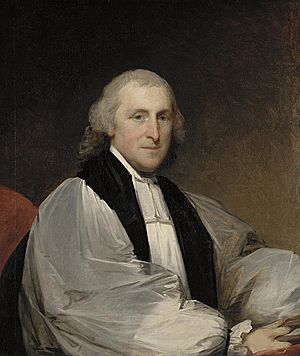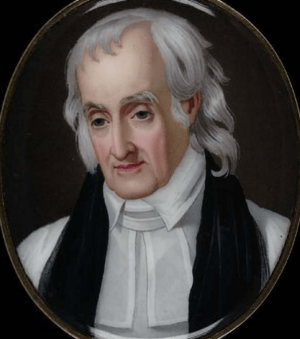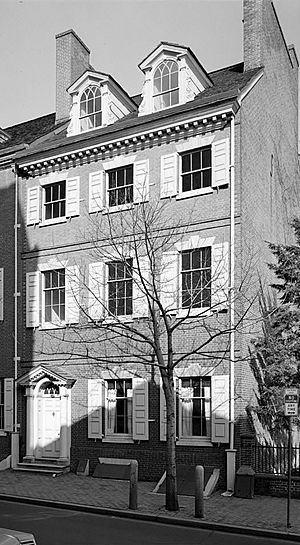William White (bishop of Pennsylvania) facts for kids
Quick facts for kids The Most Reverend William White |
|
|---|---|
| 1st and 4th Presiding Bishop of the Episcopal Church | |

White in 1795 (oil on canvas)
|
|
| Church | Episcopal Church |
| In Office |
|
| Predecessor | None (1st) Samuel Provoost (2nd) |
| Successor | Samuel Seabury (1st) Alexander Viets Griswold (2nd) |
| Other posts | Bishop of Pennsylvania (1787–1836) |
| Orders | |
| Ordination | December 23, 1770, Chapel Royal (deacon) April 17, 1772, Chapel Royal (priest) |
| Consecration | February 4, 1787, Lambeth Palace Chapel by John Moore (Canterbury) et al.; see #Consecrators |
| Personal details | |
| Born | April 4, 1748 Philadelphia, Province of Pennsylvania |
| Died | July 17, 1836 (aged 88) Philadelphia, Pennsylvania, United States |
| Buried | Christ Church, Philadelphia |
| Nationality | American |
| Denomination | Anglican |
| Parents | Thomas White & Esther Hewlings Newman |
| Spouse | Mary Harrison |
| Previous post | Bishop of Delaware (1787-1828) |
| Alma mater | Philadelphia College now known as University of Pennsylvania |
William White (born April 4, 1748 – died July 17, 1836) was an important leader in the early history of the Episcopal Church in the United States. He served as the first and fourth Presiding Bishop of the Episcopal Church. He was also the first bishop of the Diocese of Pennsylvania. Besides his church roles, he was the second Chaplain of the United States Senate.
Contents
Early Life and Education
William White was born in Philadelphia. He started his education at the College of Philadelphia, which is now known as the University of Pennsylvania. He earned his first degree in 1765.
Becoming a Priest
In 1770, White traveled to England to become a deacon. A deacon is a church leader who helps priests. He was ordained on December 23, 1770, in the Chapel Royal at St James's Palace. He went back to England in 1772 to become a priest. A priest can lead church services and perform sacraments.
Becoming a Bishop
In 1787, he returned to England one more time. On February 4, he was consecrated as a bishop. This ceremony took place at Lambeth Palace Chapel. A bishop is a senior church leader who oversees other priests and churches.
Consecrators
Several important bishops helped consecrate William White. They included:
- John Moore, the Archbishop of Canterbury
- William Markham, the Archbishop of York
- Charles Moss, the Bishop of Bath and Wells
- John Hinchliffe, the Bishop of Peterborough
William White was the second bishop consecrated for the Episcopal Church in the United States. The first was Samuel Seabury, who became a bishop in Scotland in 1784.
Church and Public Service
William White served as the main priest (Rector) for St. Peter's and Christ Church in Philadelphia for 57 years. He also worked as a chaplain for the Continental Congress from 1777 to 1789. Later, he became the Chaplain of the United States Senate.
Supporting the American Revolution
Even though he was an Anglican cleric, William White supported the American Revolution. Most Anglican priests in Philadelphia also sided with the American cause. After the war, White wrote a pamphlet called The Case of The Episcopal Churches in the United States Considered. This writing helped shape the new Episcopal Church. He suggested that regular church members, not just clergy, should help make decisions for the church. This idea was adopted, and lay people became part of the church's decision-making groups.
Leading the Episcopal Church
After becoming a bishop, White helped build the Episcopal Church in America. He helped consecrate other American bishops. He was the Episcopal Church's first and fourth Presiding Bishop. This role meant he was the most senior bishop in the church.
White also ordained two African-American men as priests: Absalom Jones and William Levington. This was an important step for the church. He supported missionary priests who traveled to spread the church's message. He even traveled to western Pennsylvania in 1825 to confirm church members and dedicate new buildings.
Community Involvement
William White was very active in helping his community. He helped create several charities and schools. He often worked with people from different Christian groups, like Presbyterians and Methodists.
- In 1785, he started the Episcopal Academy to educate children in Philadelphia.
- In 1795, he raised money to build a school for Black and Native American children. This was one of the first schools of its kind in the United States.
- In 1820, he helped create the Pennsylvania Institution for the Deaf and Dumb, which is now the Pennsylvania School for the Deaf. He served as the school's president for 16 years.
- He also helped prisoners in Philadelphia. He became the first president of the Philadelphia Society for the Alleviation of Miseries of Public Prisons.
White was known for his kindness and good deeds, especially during the yellow fever outbreaks in the 1790s. Many wealthy people left the city, but White and his friend Benjamin Rush stayed to help the sick.
Personal Life and Family
William White was married to Mary Harrison. Her father, Henry Harrison, was once the Mayor of Philadelphia. William and Mary had eight children, but only three lived to adulthood. After his wife died, White helped raise seven of his grandchildren. His widowed daughter, Elizabeth, also lived with him and managed the household.
White's younger sister, Mary, was married to Robert Morris. Robert Morris was known as the "Financier of the Revolution" because he helped get money for the American colonies during the war. White's household included a free African American coachman named John. White did not own any slaves.
William White died at his home on July 17, 1836. He was buried in the family tomb at Christ Church Burial Ground. Later, his remains were moved to Christ Church.
Bishop White House
William White's home at 309 Walnut Street in Philadelphia is now part of Independence National Historical Park. It was special because it had an indoor bathroom, which was rare at the time. His neighbor was the famous doctor Benjamin Rush.
There is another Bishop White House in Rose Valley, Pennsylvania. White sent his family there in 1793 to escape the yellow fever epidemic in Philadelphia. He visited them, but he mostly stayed in Philadelphia to help the sick.
Legacy
William White is honored by the Episcopal Church (USA) and the Anglican Church in North America on July 17. This day is his feast day on their church calendars.
See also
- List of presiding bishops of the Episcopal Church in the United States of America
- List of Episcopal bishops of the United States



